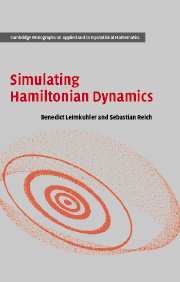Book contents
- Frontmatter
- Contents
- Preface
- Acknowledgements
- 1 Introduction
- 2 Numerical methods
- 3 Hamiltonian mechanics
- 4 Geometric integrators
- 5 The modified equations
- 6 Higher-order methods
- 7 Constrained mechanical systems
- 8 Rigid body dynamics
- 9 Adaptive geometric integrators
- 10 Highly oscillatory problems
- 11 Molecular dynamics
- 12 Hamiltonian PDEs
- References
- Index
Preface
Published online by Cambridge University Press: 04 December 2009
- Frontmatter
- Contents
- Preface
- Acknowledgements
- 1 Introduction
- 2 Numerical methods
- 3 Hamiltonian mechanics
- 4 Geometric integrators
- 5 The modified equations
- 6 Higher-order methods
- 7 Constrained mechanical systems
- 8 Rigid body dynamics
- 9 Adaptive geometric integrators
- 10 Highly oscillatory problems
- 11 Molecular dynamics
- 12 Hamiltonian PDEs
- References
- Index
Summary
About geometric integration
This book is about simulating dynamical systems, especially conservative systems such as arise in celestial mechanics and molecular models. We think of the integrator as the beating heart of any dynamical simulation, the scheme which replaces a differential equation in continuous time by a difference equation defining approximate snapshots of the solution at discrete timesteps. As computers grow in power, approximate solutions are computed over ever-longer time intervals, and the integrator may be iterated many millions or even billions of times; in such cases, the qualitative properties of the integrator itself can become critical to the success of a simulation. Geometric integrators are methods that exactly (i.e. up to rounding errors) conserve qualitative properties associated to the solutions of the dynamical system under study.
The increase in the use of simulation in applications has mirrored rising interest in the theory of dynamical systems. Many of the recent developments in mathematics have followed from the appreciation of the fundamentally chaotic nature of physical systems, a consequence of nonlinearities present in even the simplest useful models. In a chaotic system the individual trajectories are by definition inherently unpredictable in the exact sense: solutions depend sensitively on the initial data. In some ways, this observation has limited the scope and usefulness of results obtainable from mathematical theory. Most of the common techniques rely on local approximation and perturbation expansions, methods best suited for understanding problems which are “almost linear,” while the new mathematics that would be needed to answer even the most basic questions regarding chaotic systems is still in its infancy.
Information
- Type
- Chapter
- Information
- Simulating Hamiltonian Dynamics , pp. ix - xvPublisher: Cambridge University PressPrint publication year: 2005
